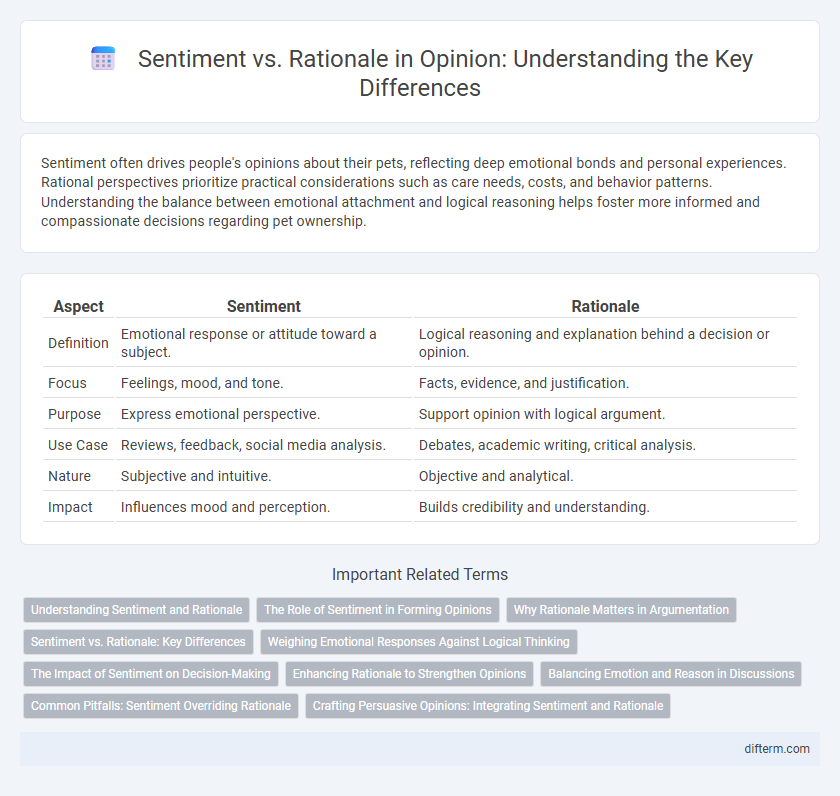Sentiment often drives people's opinions about their pets, reflecting deep emotional bonds and personal experiences. Rational perspectives prioritize practical considerations such as care needs, costs, and behavior patterns. Understanding the balance between emotional attachment and logical reasoning helps foster more informed and compassionate decisions regarding pet ownership.
Table of Comparison
| Aspect | Sentiment | Rationale |
|---|---|---|
| Definition | Emotional response or attitude toward a subject. | Logical reasoning and explanation behind a decision or opinion. |
| Focus | Feelings, mood, and tone. | Facts, evidence, and justification. |
| Purpose | Express emotional perspective. | Support opinion with logical argument. |
| Use Case | Reviews, feedback, social media analysis. | Debates, academic writing, critical analysis. |
| Nature | Subjective and intuitive. | Objective and analytical. |
| Impact | Influences mood and perception. | Builds credibility and understanding. |
Understanding Sentiment and Rationale
Understanding sentiment involves recognizing the emotional tone and subjective feelings behind opinions, reflecting how individuals emotionally engage with a topic. Rationale, on the other hand, focuses on logical reasoning and evidence-based justifications that support conclusions or decisions. Distinguishing between sentiment and rationale enhances critical thinking by balancing emotional insights with objective analysis for more informed judgment.
The Role of Sentiment in Forming Opinions
Sentiment plays a crucial role in shaping opinions by influencing how individuals perceive and interpret information beyond objective reasoning. Emotional responses often guide initial judgments, creating a foundation for beliefs that rational analysis may later support or challenge. Understanding the interplay between sentiment and rationale is essential for accurately assessing opinion formation dynamics.
Why Rationale Matters in Argumentation
Rationale forms the foundation of persuasive argumentation by providing logical evidence and coherent reasoning that support claims. Sentiment alone often lacks the critical structure needed to convince skeptics or to withstand counterarguments in rational discourse. Emphasizing rationale enhances credibility and promotes informed decision-making through clear, evidence-based communication.
Sentiment vs. Rationale: Key Differences
Sentiment is rooted in emotional responses, often shaping opinions through feelings such as happiness, anger, or fear. Rationale relies on logical reasoning and evidence, enabling objective analysis and justifiable conclusions. Understanding the key differences between sentiment and rationale helps in distinguishing emotional bias from factual judgment in decision-making processes.
Weighing Emotional Responses Against Logical Thinking
Emotional responses often provide immediate insight into personal values and experiences, while logical thinking offers structured analysis and objective evaluation. Weighing sentiment against rationale requires balancing empathy and critical reasoning to form well-rounded opinions. Effective decision-making emerges from integrating both affective and cognitive perspectives in assessing situations.
The Impact of Sentiment on Decision-Making
Sentiment plays a crucial role in shaping decision-making by often overriding purely rational analysis, leading individuals to prioritize emotional responses over logical evaluation. This influence can result in decisions driven by optimism bias, fear, or social pressures, which may not align with objective data or long-term benefits. Understanding the extent to which sentiment affects choices is essential for developing strategies that balance intuition with critical thinking in complex scenarios.
Enhancing Rationale to Strengthen Opinions
Enhancing rationale in opinions fosters clarity and critical thinking, allowing arguments to be supported by evidence rather than emotions. Strong rationale reduces biases and promotes balanced perspectives, which improves decision-making processes. Prioritizing logical reasoning over sentiment ensures opinions are persuasive, credible, and intellectually robust.
Balancing Emotion and Reason in Discussions
Balancing emotion and reason in discussions enhances clarity and fosters mutual understanding by integrating sentiment with rational arguments. Emotional expression connects participants on a human level, while rational analysis grounds the conversation in logic and evidence. Effective dialogue emerges from recognizing emotional cues without allowing them to overshadow objective reasoning.
Common Pitfalls: Sentiment Overriding Rationale
Many individuals fall into the common pitfall of allowing sentiment to override rationale, leading to biased decision-making and flawed judgment. Emotional responses often cloud critical thinking processes, causing important data and logical analysis to be overlooked. This imbalance between sentiment and rationale undermines objective evaluations in areas ranging from business strategies to interpersonal relationships.
Crafting Persuasive Opinions: Integrating Sentiment and Rationale
Crafting persuasive opinions requires a balanced integration of sentiment and rationale to effectively influence the audience. Emotional appeal captures attention and establishes a personal connection, while logical reasoning strengthens credibility and supports the argument with evidence. Combining heartfelt sentiment with clear rationale creates compelling, trustworthy opinions that resonate and persuade.
sentiment vs rationale Infographic

 difterm.com
difterm.com